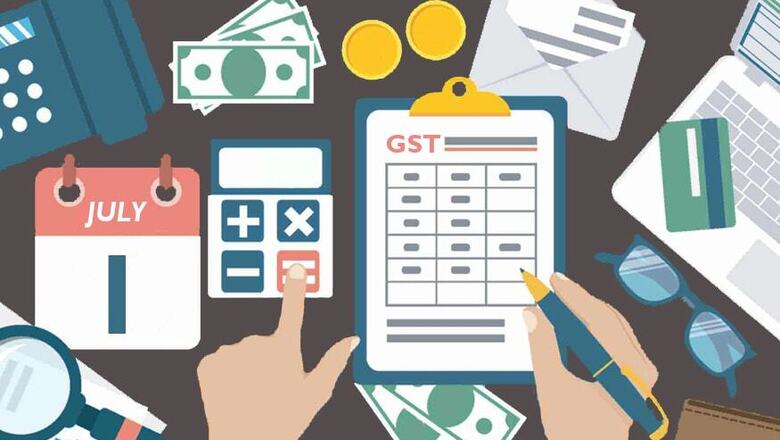
views
New Delhi: The Goods and Service Tax (GST) regime in India has been marked as one of the biggest tax overhauls since independence. It has been designed to replace the complex set of more than a dozen levies, imposed by the central and state governments, with a uniform national levy.
This reform is expected to result in numerous benefits for stakeholders and bring economic integration in the country. The GST is aimed at unifying tax rates and facilitate ease of doing business, resulting in India being one unified market. GST aims at a system of seamless input credit that would flow through the entire value chain, which would help eliminate cascading effect of taxes and consequently reduce cost of doing business. This would eventually lead to a situation where the domestically manufactured goods and services are available at lower prices, which would increase their competitiveness in the international market and give impetus to Indian exports.
The GST is a consumption-based tax and a dual levy with state GST and Central GST. Further, for inter-state supplies Integrated GST (IGST) i.e. the aggregate of state GST and central GST will apply. The GST will be a unified tax on supply of goods and services. It is aimed at being a tax only on value addition. Through the system of availability of taxes paid in form of input credit, in effect, the customer would be charged only for GST as levied by the last dealer in the chain, as for all previous stages the input credit would be available to set-off GST liability.
What happens to businesses that haven’t opted for Composition Scheme
GST regime requires taxpayers to file monthly returns. For those who are registered with GSTN (GST Network), and have not opted for Composition Scheme, would need to file the following returns:
• GSTR-1: Related to an outward supply of taxable goods and services and is to be filed by the 10th of next month. GSTR-1 essentially is filing of sales invoices of the previous month, in the format provided by GSTN.
• GSTR-2: Related to an inward supply of taxable goods and services and to be filed by the 15th of next month. GSTR-2 is provided by GSTN and the taxpayer has to simply check it against their purchase register. This ensures that the taxpayer does not lose on any tax credit.
• GSTR-3: This is the monthly return and is to be filed by the 20th of next month. Again, this is provided by GSTN. It needs to be downloaded from GSTN, verified and filed.
• GSTR-9: This is the annual return to be filed along with the financial statements by 31st December of the next financial year.[i]
What happens under Composition Scheme Composition Scheme under the GST regime is aimed at facilitating ease of implementation and compliance process by small taxpayers. This scheme allows qualifying taxpayers (whose turnover in the preceding financial year was less than 50 lakh) to pay a percentage of their yearly turnover in a state as tax. Further, under this scheme taxpayers would be required to file summarized returns on a quarterly basis instead of monthly returns. Returns to be filed under the Composition Scheme are:
• GSTR-4: Quarterly return to be filed under composition scheme by the 18th of the month succeeding quarter.
• GSTR-9A: This is the simplified annual return to be filed under the under the Composition Scheme by 31st December of the next financial year.
GST is expected to significantly impact the Indian economy. From an end customer’s standpoint, there are certain benefits which the new regime would garner. GST is expected to minimize the cascading effect of taxes and remove hidden and embedded costs that the customers had to pay up-until-now. This would also ensure more transparency in the system as the customers will now have a fair visibility on the taxes being charged to them and the basis for the same. Further, GST implementation is expected to result in a seamless flow of input credits. With this, the net amount of indirect taxes implanted in the value chain would reduce and ultimately would result in relatively lesser prices of goods and services in the ordinary scenario. The anti-profiteering measures incorporated in the regime would push businesses to pass down benefits on account of GST to the end customer.
Benefits of GST are primarily dependent on the successful adoption of GST across all enterprises. While larger organizations that have an existing ERP or electronic invoicing system would possibly be able to step up and adopt GST faster, they would still need to ensure that their vendors/distributors/dealers are all GST enabled in order to claim valid tax credits. Further, larger the transaction base, greater the probabilities of invoice mismatches, necessitating reconciliations which would involve a big workforce.
On the other hand, for the Micro, Small and Medium Enterprises (MSME) segment GST entails a mammoth overhaul. With limited or no information technology solution or invoicing system prevalent, this segment would find it a challenge to adopt GST, given its complexity.
It would also entail significant upfront costs to adopt the minimal technology needed to effectively and efficiently be part of the GST regime, which is critical for the for the success of this regime.
Effective adoption of the new regime and its implementation, especially by the MSME segment becomes undeniably critical. It is imperative for small vendors to enter invoices electronically, as non-compliance by one entity in the value chain would impact other entities in the value chain including large organizations and, in effect, defeat the intention of a unified tax structure.
To address this issue that concerns over millions of MSME’s registered with GST Network (GSTN) in India, many software are now available.
It is critical to have the MSME’s become GST compliant as they contribute to over 40% of the economy and provide bulk of the non-agricultural jobs. Moreover, large firms cannot be GST compliant unless their ecosystem of MSME’s are also GST enabled since if their MSME supplier is unable to file their GST returns, the larger firms will not be able to claim their input tax credits.
The transition to GST will be challenging as seen with other countries. Malaysia ended up having months of protest despite providing a year and a half for the industries to get ready. Empirically, GST also leads to inflation initially, as not only the tax rates are slightly higher, but also as the tax evasion is reduced, leading to an added cost of tax in the supply chains. Eventually, the benefits of GST start kicking in, leading to a reduction in costs, and hence prices, leading to a reduction in the cost to the economy.
The GST would need the support of the government and the industry to make it a success. It would be critical to ensure that the MSME’s are provided a helping hand for this transition. We would expect a significant number of fine tunings to happen before the GST regime settles down. At the end of it, the economic gains of GST would be worth the transitionary pain.
(Author is Partner and Head, Economics, Regulatory and Policy Advisory, KPMG in India. Views are personal)




















Comments
0 comment